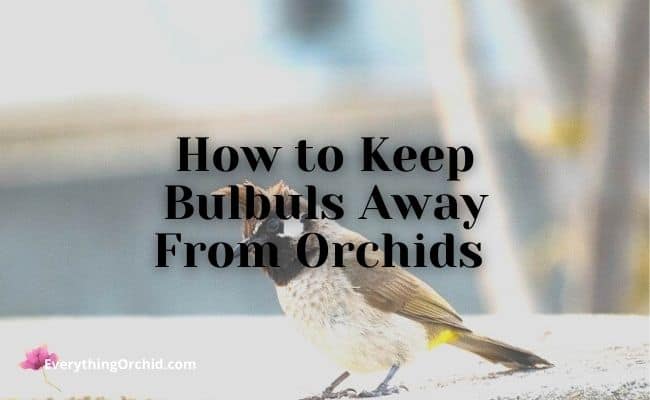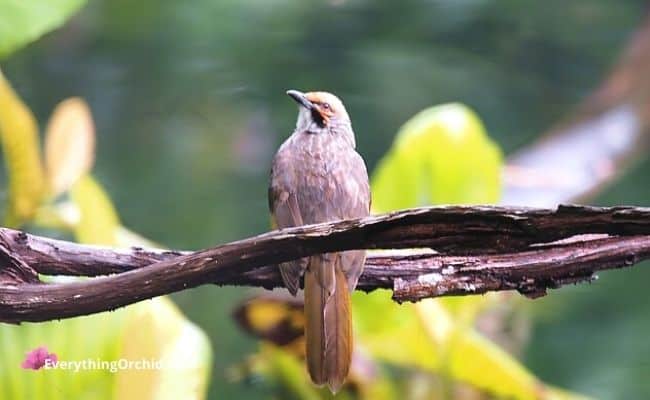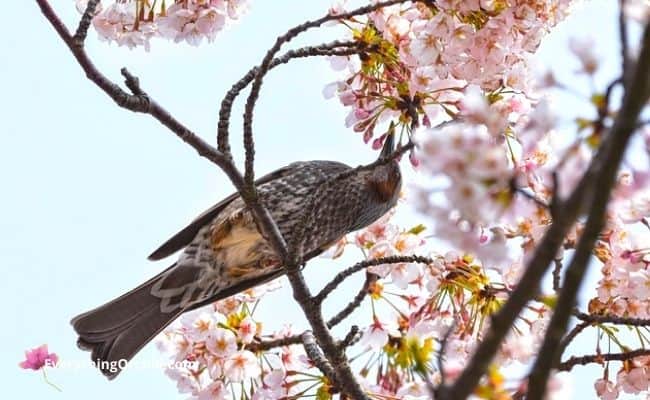Want to know how to keep bulbuls away from orchids and gardens? You’ve come to the right place! This species of bird is present in warm, tropical regions throughout the world. You may have noticed this beautiful songbird flying around your yard.
Bulbuls and other birds will eat your orchids and other blooming plants. It is important to immediately take action if you notice bulbuls or any species of birds eating your orchids.
This bird is beautiful and can be exciting for any birdwatcher to see. These birds are perfectly harmless to humans and most other animal species. But they can be extremely destructive to any outdoor plants and gardens.
In this blog post you will find information on bulbuls and orchids including:
- What bulbuls are
- Where you can find bulbuls
- Bulbul’s diet
- Signs bulbuls are eating your orchid and other outdoor plants
- Different ways you can keep bulbuls away from your orchid and gardens
- Natural remedies you can use to repel bulbuls away
There are different steps you can take for your orchid and bulbuls to coexist with one another outdoors. By the end of this post you will be an expert on bulbuls and ways you can keep these birds away from your plants and from eating your orchids.
Keep reading to learn more!
FTC Disclosure: This website contains affiliate links. If you choose to purchase any items, EverythingOrchid will receive a commission at no additional cost to you.

Table of Contents
What are Bulbuls?
Bulbuls are a species of the passerine songbird. There are over 120 different species of bulbuls in 32 genera throughout the world. Different species include the red-whiskered bulbul, the brown-eared bulbul, and the hairy-backed bulbul just to name a few.
Most species of bulbuls are small to medium in size. The majority of bulbul species can grow anywhere to be 13 centimeters in length to 29 centimeters. Bulbuls, like most birds, are covered with feathers throughout its entire body.
Songbirds such as bulbuls tend to have slightly elongated beaks that can be several centimeters in length and curve at the end. Bulbuls have long tails and short-rounded wings.
Different species may appear in a variety of different colors, including yellow, red, brown, black, and tan. Markings and crests throughout the bulbul’s feathers may differ from other species.
Almost all female species of bulbuls tend to be slightly smaller than males. But male and females typically look the same.
Bulbul Reproduction and Life Cycle
Bulbuls are one of the few monogamous species within the animal kingdom (with the exception of the yellow-whiskered greenbul). Male and female bulbuls normally only have one partner in life and a female can lay up to 5 eggs at a time once bred.
Incubation for the bulbul’s eggs last up to 2 weeks. After 2 weeks, the eggs will hatch. Once the egg hatches, a hatchling will emerge. During the hatchling stage, the baby bulbuls live in the nest and depend on care from not only their parents, but other non-breeding bulbuls.
Bulbuls are one of the many different species that uses alloparenting techniques to look after hatchlings.
Alloparenting is a practice where younger-less mature animals will tend to and look after newborns. This helps the parents be able to carry on daily-functions and responsibilities, such as gathering food or materials for shelter. The extra care helps in providing more safety and security to the newborn animals.
Hatchling bulbuls will be ready to leave and fledge the nest once they reach 16 days old.

Where do Bulbuls Live?
Bulbuls are originally native to regions throughout Africa, the Middle East, and various regions throughout Asia. This type of bird favors warm, tropic-like regions and usually can be found living in various rainforests. Bulbuls tend to only build nests in high trees (for protection from predators).
Today, there are several different species of bulbuls that have become invasive to several regions including Florida, Fiji, Australia, and Hawaii.
Capturing and trading bulbuls in the pet trade has become a popular practice throughout the world. This has been the main cause for why bulbuls are now considered an invasive species in these regions.
Bulbuls have gained a reputation for eating and destroying various crops and have become a great disturbance on many farms and orchards.
What do Bulbuls Eat?
Songbirds like bulbuls are perfectly harmless to humans. Bulbuls are omnivores.
This bird tends to favor a variety of different fruits (favoring nectarous fruits) and flowers (including orchids) in their diet. Bulbuls will also eat and consume seeds, small insects, anthropods and small vertebrate animals (like small lizards or frogs).
Bulbuls will eat almost anything found in your garden, from flowering plants to vegetable and fruit gardens. Since this bird is invasive to several regions in the world, they have become a problem for farming and crops.
It is important to take necessary precautions to keep bulbuls from eating your orchids and gardens. Overtime, you may be left with bare and unflattering plants if this problem is left untreated.

How to Tell Bulbuls are Eating Your Orchids
You will be able tell whether a bulbul or other bird is eating your orchid or based on the appearance of your plant. If one moment the leaves and blooms are fully intact, and the next they’re gone, then your orchid may have been eaten by a bulbul or other bird.
Bulbuls can quickly consume and destroy your orchid and other plants.
You may notice chew marks on the orchid’s leaves or partially eaten blooms. Also if you happen to see this bird on or near your orchid, then this may be a good indicator that it is the culprit responsible for eating your plant.
7 Ways to Keep Bulbuls Away From Orchids and Your Outdoor Gardens
Orchids and other outdoor plants are extremely vulnerable to birds and other pests. Bulbuls can fly, making almost anything easy access for their own pleasure and consumption.
There are a number of different ways you can keep bulbuls, and even other pests, away from your orchids and outdoor gardens. Below you will find 7 different ways to keep bulbuls away from your outdoor orchids and gardens.
Keep reading to find out more!
1. Move Your Orchid Indoors
One of the best and most effective methods to keep bulbuls from eating your orchid is by placing your plant indoors. Bulbuls and other outdoor pests (such as iguanas) will be unable to access your orchid if you place it in your home. Orchids will help brighten up any room you put it in!
Once the orchid is inside, be sure to place it in well-lit areas of your home. Orchids will need at least 8 hours of sunlight each day to properly thrive. Most species of orchids also need to be placed in temperatures that are at least 70 degrees Fahrenheit during the day.
Avoid placing your orchid in drafty areas. If it becomes too cold for your plant, try using additional lighting sources or portable heaters to help increase the temperature.
2. Apply Garden Netting Around Your Orchids
Another option for keeping bulbuls away from your orchids and gardens is by placing garden netting around your plants.
Garden netting will restrict the bulbuls and other pest’s access to your orchid and gardens by acting as a barrier. You can either drape the netting over your plants or you can build your own frame around your garden and orchids.
You can use any type of durable wood to build a frame. Once the frame is build, drape and secure the netting (you can use fishing wire, zip-ties, etc., to hold the net in place). Be sure that the netting completely touches the ground and covers the entire top of your orchid to keep bulbuls away.
Mesh Garden Netting (8’x24′)-$20
This Mesh Garden Netting is perfect to use if you are looking for a way to keep bulbuls and other pests away from your outdoor orchids and gardens. The netting is super durable (making it so the birds can’t rip it) and ultra-fine making it so the birds and other pests unable to penetrate through the netting.
The Mesh Garden Netting allows for good air flow to your orchid and proper amounts of light, all while protecting your orchids from bulbuls and other orchid pests!
3. Hang Wind Chimes Near Your Orchids and Gardens
Loud noises are another way to deter bulbuls and other pests away from your yard. Consider installing wind chimes near or around your garden and outdoor orchids to keep bulbuls away.
You will want to be sure that the wind chimes are directly near your orchid or other plants that you are trying to protect. There is no sense in using wind chimes if they are on your porch or very distant from your plants, as they won’t be loud enough from long distances to keep pests away.
Corinthian Bells Windchime (29 in-Black)-$84

Wind chimes are the perfect way to keep bulbuls and other pests away from your outdoor orchids and gardens! The beautiful sounds produced from the wind chimes when the hit together frighten the bulbuls. You can place the Corinthian Bells Windchime in various regions in your yard (such as in trees, porches, or patios) near your orchids and gardens.
The Corinthian Bells Windchime is made of aluminum and is durable to all types of weather conditions. This product will not rust and is reinforced with strong strings (which hold the chimes together).
4. Let Your Pets Out if you Notice Bulbuls in Your Yard
Have a dog that loves to roam your yard and bark? Dogs and other big, loud pets can be a perfect method to use for keeping bulbuls away. Immediately let your pets out if you notice bulbuls or other pests in your yard.
The bird will become frightened at the sight and sound of your dog or other animals in your yard and will most likely stay away.
5. Place Owl or Other Predator Figurines in Your Gardens
One harmless technique you can consider using to keep bulbuls away from your orchids and garden is by placing figurines and statues of bulbul predators throughout your yard and garden.
Different predators of bulbuls include owls, snakes, hawks and other large birds. Most bulbuls will most likely stay away if they spot one of their natural predators and even statues and figurines of their predators.
You can also try playing different sounds that these predators may make as a way to frighten the bird and keep them from destroying your orchids and other outdoor plants.
Predatory Owl Figurine-$22

Owls are natural predators of bulbuls and other small birds and pests. You should consider placing this Predatory Owl Figurine in your gardens or near your orchids to keep these pests away from your plants.
Even though the owl is plastic and fake, the presence of the figurine is enough to frighten bulbuls. This is a highly effective tool to use to keep bulbuls from eating your orchids and other outdoor plants.
6. Place Garden Spinners (Pinwheels) Throughout Your Yard to Keep Bulbuls Away From Your Orchids
Other options to keep bulbuls away from your orchids and outdoor plants include placing garden spinners or other reflective objects throughout your yard and trees.
You can use either garden spinners, CDs, broken glass or mirror, or other reflective objects for this method. Bulbuls and other birds will become frightened by any sudden movement. The constant reflection of light off these objects will scare the birds and keep them away.
Be sure to place the reflective objects in areas that receive lots of sunlight. The more light these objects reflect, the better they will be at keeping bulbuls and other birds away from your orchids and gardens.
Bird Repellent Holographic Pinwheel (pack of 10)-$28

The Bird Repellent Holographic Pinwheel is an effective tool that will keep bulbuls and other pests away from your orchids and outdoor gardens. The pinwheel reflects sunlight when ever they spin, frightening the bulbuls. You can place multiple of the pinwheels throughout your garden and yard to keep pests away from your plants.
7. Soak Dried-Corn in Whiskey and Spread it Around Your Orchid and Garden
Another option you can try to use to keep bulbuls away from your orchids and gardens is by soaking dried-corn in whiskey and spreading it around your yard and garden.
Bulbuls love to eat things such as dried-out corn. The smell of the whiskey will also attract the birds more than the smell of orchids or other plants. Simply take several quarts of dried-corn and soak the corn in whiskey (usually you will need 1-2 cups of whiskey for every one quart of corn).
This method may help keep bulbuls and other pests away from your plants, but it may attract more guests in your yard than you would care for. You will want to avoid using this method regularly, as you do not want bulbuls or other animals becoming accustomed to be given food daily. Bulbuls, other birds and animals will keep coming back if you keep feeding them.
I recommend using this method as a last resort.
Want to know more ways to keep bulbuls and other birds or predators away from your orchids and gardens? Check out this link on humane ways to keep birds out of your garden now!
How to Keep Bulbuls Away From Orchids: Summarized
Songbirds such as bulbuls may sound delightful and bring joy to your ears, but they can bring much destruction to your orchids and gardens if you do not take necessary measures to keep this pest away.
If you have orchids outdoors and are being attacked and eaten by bulbuls, you should immediately take action.
Bulbuls are fascinating birds that can lay up to 5 eggs at a time. There are over 120 different species of bulbuls known throughout the world today.
This bird is native to regions and tropical rainforests throughout Africa, Asia, and the Middle East. More recently, bulbuls have become an invasive species to several regions throughout the world and have cause much destruction to crop fields, orchards, and many outdoor plants and gardens.
Though bulbuls help in the sense that they may eat insects or other small vertebrates that are near, these birds may also eat your orchid and garden.
Methods to Keep Bulbuls Away from Orchids and Gardens: Summarized
There are 7 different methods and techniques you can try using in attempting to keep bulbuls and other pests away from your orchids and gardens. These methods include:
- Moving your orchid or other plants indoors if possible
- Place garden netting around your plants
- Hang wind chimes or other loud objects directly near your orchid and garden
- Let your pets outdoors to scare bulbuls and birds away
- Place predator statues and figurines throughout your yard and garden
- Install garden spinners or other reflective objects throughout your yard to scare the birds
- Spread dried-corn soaked in whiskey around your yard and plants
If you try one of these methods and find no success, simply move onto another method to keep bulbuls away. One of the methods above (especially moving your orchid indoors) are bound to work in protecting your plants from bulbuls and even other orchid pests.
You should always treat bulbuls with respect and care and never attempt to harm these birds or any animal when trying to keep them away from your plants.
By now you have read everything you need to know about bulbuls (from their physical characteristics to behaviors) and ways to keep these birds away from your orchids and gardens.
Though these songbirds are completely harmless to humans, they have proven over and over again the type of destruction they can even cause to big crop fields and outdoor plants.
Be sure to always take action if you notice any type of pest messing with your orchids or other plants.
Thanks for reading!
FTC Disclosure: This website contains affiliate links. If you choose to purchase any items, EverythingOrchid will receive a commission at no additional cost to you.

